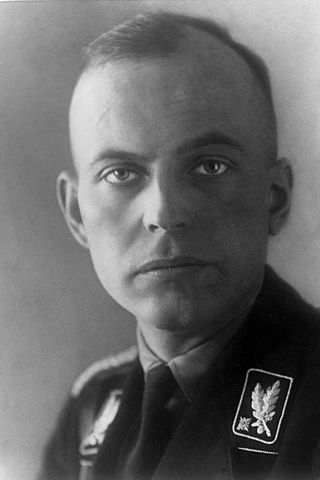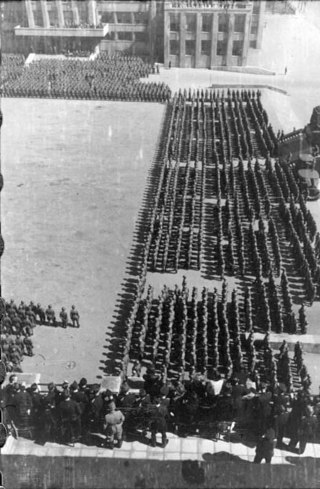
The Ordnungspolizei, abbreviated Orpo, meaning "Order Police", were the uniformed police force in Nazi Germany from 1936 to 1945. The Orpo organisation was absorbed into the Nazi monopoly on power after regional police jurisdiction was removed in favour of the central Nazi government. The Orpo was controlled nominally by the Interior Ministry, but its executive functions rested with the leadership of the SS until the end of World War II. Owing to their green uniforms, Orpo were also referred to as Grüne Polizei. The force was first established as a centralised organisation uniting the municipal, city, and rural uniformed police that had been organised on a state-by-state basis.

Hans-Adolf Prützmann was among the highest-ranking German SS officials during the Nazi era. From June 1941 to September 1944, he served as a Higher SS and Police Leader in the occupied Soviet Union, and from November 1943 was the Supreme SS and Police Leader in Ukraine. He oversaw the activities of the Einsatzgruppen detachments that perpetrated the Holocaust in the Baltic States and Ukraine. After being captured at the end of the Second World War, he committed suicide.
The Geheime Feldpolizei, shortened to GFP, was the secret military police of the German Wehrmacht until the end of the Second World War (1945). Its units carried out plainclothes and undercover security work in the field. Their operations included clandestine operations, counterpropaganda, counterinsurgency, counterintelligence, creation of a counterinsurgency intelligence network, detection of treasonable activities, infiltration of resistance movements, gathering intelligence and destroying targets, protecting military installations, assisting the German Army (Heer) in courts-martial investigations, tracking and raiding targets to capture or kill, and setting-up security checkpoints in high-risk areas. GFP personnel, who were also classed as Abwehrpolizei, operated as an executive branch of the Abwehr, detecting resistance activity in Germany and in occupied France. They were also known to carry out torture and executions of prisoners.
Hermann Franz was a high-ranking commander in the police of Nazi Germany. He was the commander of the Police Regiment South, which perpetrated mass murder in the Holocaust in the Army Group South Rear Area. In 1942 he became commander of the 18th Mountain Police Regiment. Subsequently, Franz served as commander of the Ordnungspolizei in Greece and then became Higher SS and Police Leader Greece in autumn 1944, then commander of the Ordnungspolizei in Norway.

Max von Schenckendorff was a general in the Wehrmacht of Nazi Germany during World War II. He was the commander of Army Group Rear Area behind Army Group Centre from March 1941 until his death. He is best known for organising the Mogilev conference, in which Wehrmacht and SS officers discussed "bandit fighting" tactics, meaning the mass murder of Jews and other real or perceived enemies. The conference resulted in an intensification of the genocide that was already taking place in Army Group Centre Rear Area.
Army Group Rear Area Command was an area of military jurisdiction behind each of the three Wehrmacht army groups from 1941, the German invasion of the Soviet Union in Operation Barbarossa, through 1944 when the pre-war territories of the Soviet Union were recovered. The areas were sites of mass murder during the Holocaust and other crimes against humanity targeting the civilian population.
The Mogilev Conference was a September 1941 Wehrmacht training event aimed at improving security in the rear of Army Group Centre during the German invasion of the Soviet Union. The event was organised by General Max von Schenckendorff, commander of Army Group Centre Rear Area, in cooperation with the officials of the security and intelligence services of Nazi Germany—SS and the Sicherheitsdienst —operating in the same area. Ostensibly an "anti-partisan" training conference, the event marked an escalation of violence against Jews and other civilians in the areas under Schenckendorff's command.

The Police Regiment Centre was a formation of the Order Police during the Nazi era. During Operation Barbarossa, it was subordinated to the Schutzstaffel (SS) and deployed in German-occupied areas, specifically the Army Group Centre Rear Area, of the Soviet Union. In mid-1942, its three constituent battalions were reassigned and the unit was re-designated as the 13th Police Regiment.
The Police Regiment South was a formation of the German Order Police, the German national uniformed police force, during the Nazi era. During Operation Barbarossa, it was subordinated to the Schutzstaffel (SS) and deployed in German-occupied territories, specifically the Army Group South Rear Area. In July 1942, its three constituent battalions were redesignated as the 10th Police Regiment.
Army Group North Rear Area was one of the three Army Group Rear Area Commands, established during the 1941 German invasion of the Soviet Union. Initially commanded by General Franz von Roques, it was an area of military jurisdiction behind Wehrmacht's Army Group North.
Kommandostab Reichsführer-SS was a paramilitary organisation within the SS of Nazi Germany under the personal control of Heinrich Himmler, the head of the SS. Established in 1941, prior to the German invasion of the Soviet Union, it consisted of the Waffen-SS security forces deployed in the occupied territories. The units perpetrated mass murder against Jews and other civilians.
The Police Battalion 322 was a formation of the German Order Police during the Nazi era. During Operation Barbarossa, it was subordinated to the SS and deployed in German-occupied areas, specifically the Army Group Centre Rear Area, of the Soviet Union, as part of Police Regiment Centre.
The Police Battalion 316 was a formation of the Order Police during the Nazi era. During Operation Barbarossa, it was subordinated to the SS and deployed in German-occupied areas, specifically the Army Group Centre Rear Area, of the Soviet Union, as part of Police Regiment Centre. Alongside detachments from the Einsatzgruppen and the SS Cavalry Brigade, it perpetrated mass murder in the Holocaust and was responsible for large-scale crimes against humanity targeting civilian populations under the guise of "anti-partisan" warfare. In mid-1942, the battalion was reassigned to the 4th Police Regiment and operated in Slovenia.
The Police Battalion 307 was a formation of the Order Police during the Nazi era. During Operation Barbarossa, it was subordinated to the SS and deployed in German-occupied areas, specifically the Army Group Centre Rear Area, of the Soviet Union, as part of Police Regiment Centre. Alongside detachments from the Einsatzgruppen, it perpetrated mass murder in the Holocaust and was responsible for large-scale crimes against humanity targeting civilian populations. In mid-1942, the battalion was reassigned to the 23rd Police Regiment and operated in Belarus.
The Police Battalion 314 was a formation of the German Order Police during the Nazi era. During Operation Barbarossa, it was subordinated to the SS and deployed in German-occupied areas, specifically the Army Group Centre Rear Area, of the Soviet Union, as part of Police Regiment South. Alongside detachments from the Einsatzgruppen and the 1st SS Infantry Brigade, it perpetrated mass murder in the Holocaust and was responsible for large-scale crimes against humanity targeting civilian populations.
The Police Battalion 303 was a formation of the German Order Police during the Nazi era. During Operation Barbarossa, it was subordinated to the SS and deployed in German-occupied areas, specifically the Army Group Centre Rear Area, of the Soviet Union, as part of Police Regiment South. Alongside detachments from the Einsatzgruppen of the SD and the 1st SS Infantry Brigade of the Waffen-SS, it perpetrated mass murder in the Holocaust and was responsible for large-scale crimes against humanity targeting civilian populations.
The Police Battalion 45 was a formation of the German Order Police during the Nazi era. During Operation Barbarossa, it was subordinated to the SS and deployed in German-occupied areas, specifically the Army Group Centre Rear Area, of the Soviet Union, as part of Police Regiment South. Alongside detachments from the Einsatzgruppen of the SD and the 1st SS Infantry Brigade of the Waffen-SS, it perpetrated mass murder in the Holocaust and was responsible for large-scale crimes against humanity targeting civilian populations.
The Police Battalion 320 was a formation of the German Order Police during the Nazi era. During Operation Barbarossa, it was subordinated to the SS and deployed in German-occupied areas, specifically the Army Group South Rear Area, of the Soviet Union, as part of Police Regiment Special Purpose. Alongside detachments from the Einsatzgruppen of the SD, it perpetrated mass murder in the Holocaust and was responsible for large-scale crimes against humanity targeting civilian populations.
The Police Battalion 309 was a formation of the Order Police during the Nazi era. During Operation Barbarossa, it was subordinated to the German Army's 221st Security Division and deployed in German-occupied areas, specifically the Army Group Centre Rear Area, of the Soviet Union, as part of Wehrmacht's security forces. Alongside detachments from the Einsatzgruppen and the SS Cavalry Brigade, it perpetrated mass murders and was responsible for large-scale crimes against humanity targeting civilian populations.

The Order Police battalions were militarised formations of the Nazi German Ordnungspolizei. During World War II, they were subordinated to the SS and deployed in German-occupied areas, specifically the Army Group Rear Areas and territories under German civilian administration. Alongside detachments from the Einsatzgruppen and the Waffen-SS, these units perpetrated mass murder of the Jewish population and were responsible for large-scale crimes against humanity targeting civilian populations.




